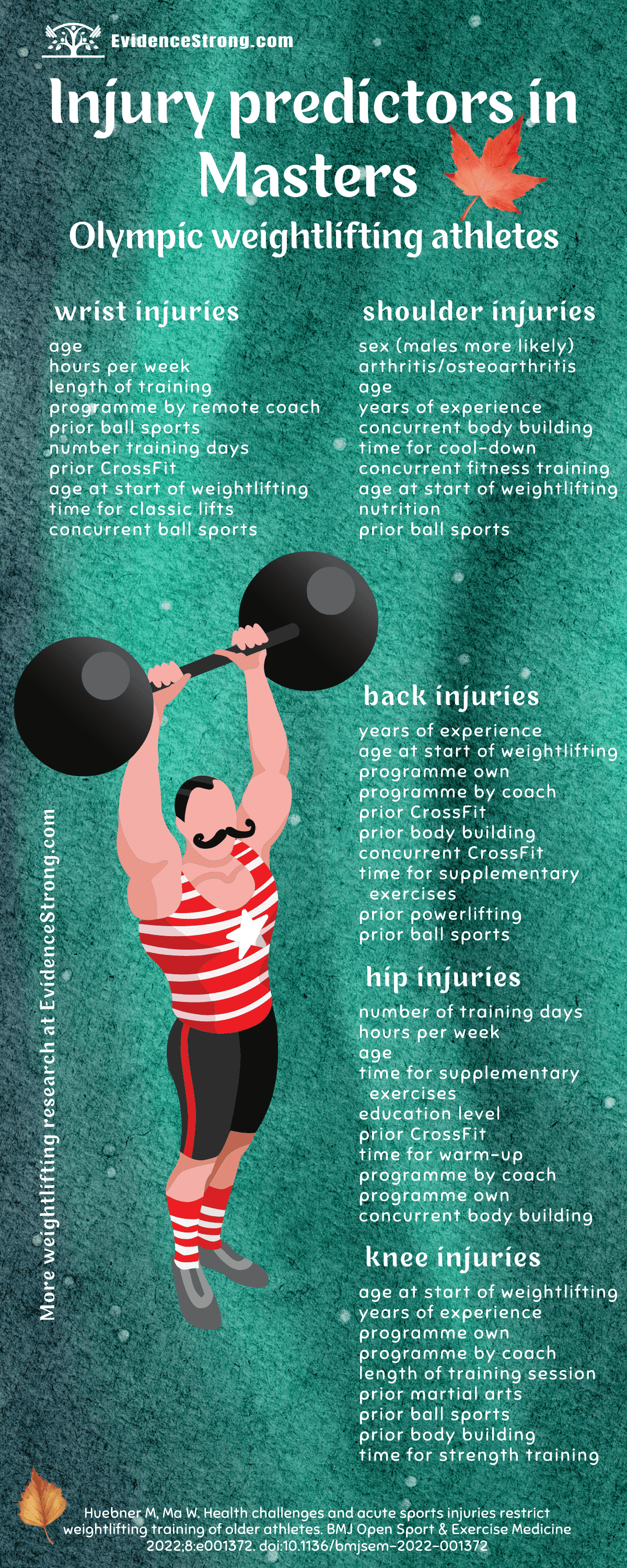Summary of a study investigating the predictors of injuries in Masters Olympic weightlifters.
Who
976 complete data sets from Masters (aged 35 and above) Olympic weightlifters (51% females) with a median age of 48 years (Australia, Canada, Germany, Great Britain, Spain, and the USA).
Design
Analysis of survey data
Outcome measures/tests
- injuries in relation to participation in weightlifting (‘Have you ever had training restrictions due to acute injuries sustained during or while performing weightlifting?‘)
- concurrent training and sports participation
- time for specific parts of weightlifting training: warm-up, classic lifts (snatch, clean and jerk and accessories such as hang snatch or clean from blocks), strength exercises (squats, presses), additional exercises (pull-ups, core, machines, etc) and cool-down
- whether following a training-specific nutrition programme was important for their weightlifting training (ie, recovery, muscle increase).
Main results
- Common sites for weightlifting injuries:
- shoulders (35%)
- knees (26%)
- back (23%)
- wrists (21%)
- Less common injury sites:
- hips (13%)
- elbows (12%)
- ankles (2%)
- Men were almost twice as likely to sustain injuries of shoulders, back, knees or wrists than women.
- At younger ages, injuries were more likely to occur for knees and wrists.
- Chronic inflammation/osteoarthritis was present in all age groups and increased the risk at all injury locations.
- Longer time spent on supplementary exercises was associated with sustaining wrist injuries and longer time to cool-down was associated with an increased risk for shoulder injuries.
- Following their own programme was associated with knee injuries.
- Concurrent CrossFit training was associated with back injuries.
- Concurrent yoga/Pilates lowered the risk of back injuries.
- Those who believe that following a specific nutrition programme was important for their weightlifting training (i.e., recovery, muscle increase) were less likely to report a shoulder injury.
- Prior sport participation (bodybuilding, powerlifting, ball sports, gymnastics) was not associated with an injury risk sustained during weightlifting.
- Most (92%) of the respondents engaged in physical activities or had sport experience prior to starting weightlifting.
- Comorbidities increased with older ages and included:
- high blood pressure: men (26%), women (7%)
- cardiovascular disease
- diabetes
- cancer
Take home message
For a clinician & coach
Common sites of weightlifting injuries in Masters athletes were shoulders, knees, back and wrists. Chronic inflammation/osteoarthritis was present in all age groups and increased the risk at all injury locations. Men were almost twice as likely to sustain injuries of shoulders, back, knees or wrists than women. Prior sport participation (bodybuilding, powerlifting, ball sports, gymnastics) was not associated with an injury risk sustained during weightlifting. Concurrent yoga/Pilates lowered the risk of back injuries, but concurrent CrossFit was associated with back injuries. Those who believe that following a specific nutrition programme was important for their weightlifting training (i.e., recovery, muscle increase) were less likely to report a shoulder injury.
For a parent
Common sites of weightlifting injuries in Masters athletes were shoulders, knees, back and wrists. Chronic inflammation/osteoarthritis was present in all age groups and increased the risk at all injury locations. Men were almost twice as likely to sustain injuries of shoulders, back, knees or wrists than women. Prior sport participation (bodybuilding, powerlifting, ball sports, gymnastics) was not associated with an injury risk sustained during weightlifting. Concurrent yoga/Pilates lowered the risk of back injuries, but concurrent CrossFit was associated with back injuries. Those who believe that following a specific nutrition programme was important for their weightlifting training (i.e., recovery, muscle increase) were less likely to report a shoulder injury.
For an athlete
Common sites of weightlifting injuries in Masters athletes were shoulders, knees, back and wrists. Chronic inflammation/osteoarthritis was present in all age groups and increased the risk at all injury locations. Men were almost twice as likely to sustain injuries of shoulders, back, knees or wrists than women. Prior sport participation (bodybuilding, powerlifting, ball sports, gymnastics) was not associated with an injury risk sustained during weightlifting. Concurrent yoga/Pilates lowered the risk of back injuries, but concurrent CrossFit was associated with back injuries. Those who believe that following a specific nutrition programme was important for their weightlifting training (i.e., recovery, muscle increase) were less likely to report a shoulder injury.
Original article
Huebner M, Ma W. Health challenges and acute sports injuries restrict weightlifting training of older athletes. BMJ Open Sport & Exercise Medicine. 2022 Jun 1;8(2):e001372.
You might want to read next
How did pandemic affect Olympic weightlifters?
How does weightlifting affect other parts of life?
How does Olympic weightlifting performance change across ages?
